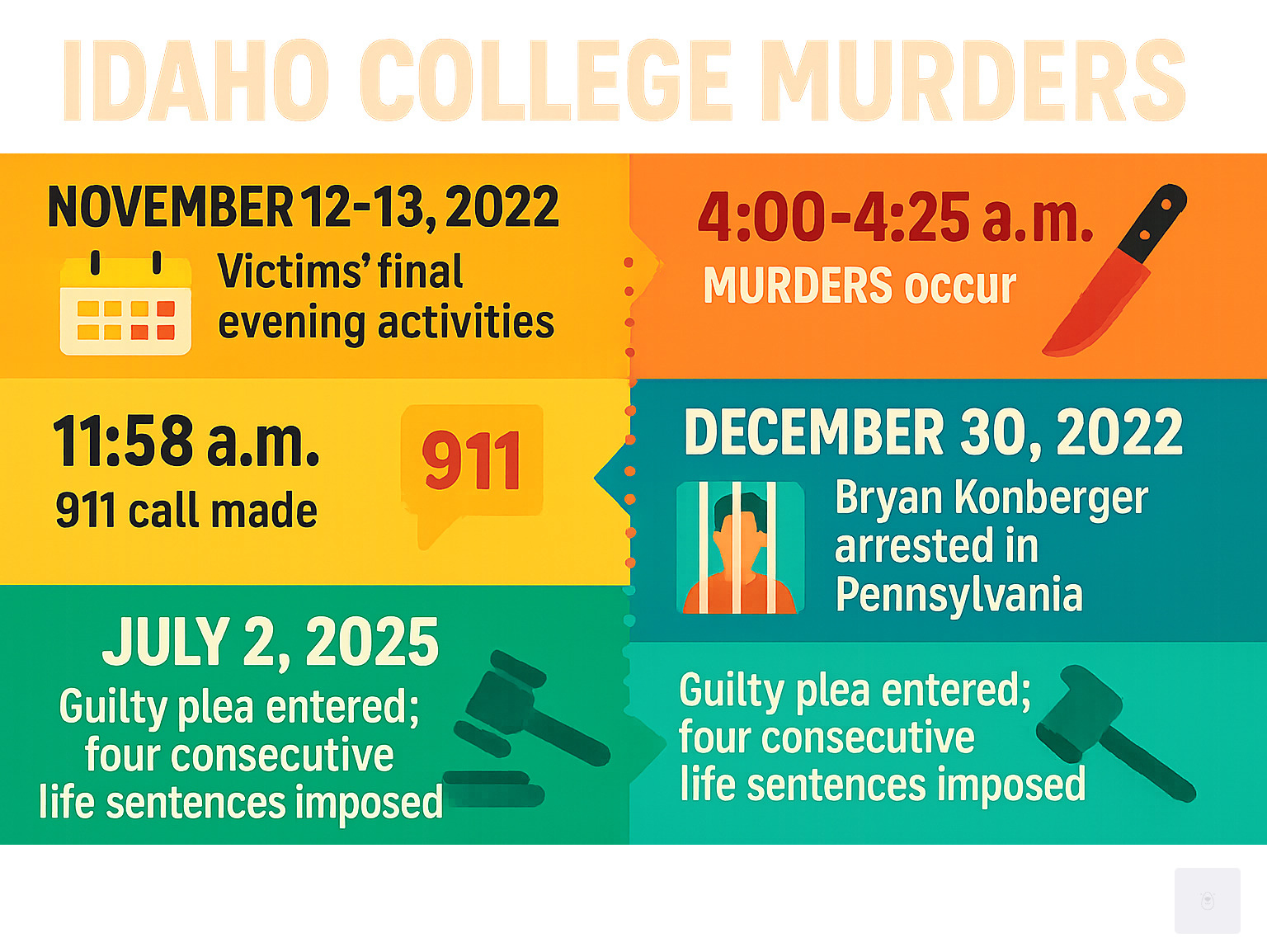
A Shocking Crime That Captured National Attention
The Idaho college murders shocked the nation when four University of Idaho students were brutally stabbed to death in their off-campus home in Moscow, Idaho, on November 13, 2022. Here are the key facts:
The Victims:
- Kaylee Goncalves, 21
- Madison Mogen, 21
- Xana Kernodle, 20
- Ethan Chapin, 20
The Crime:
- Date: November 13, 2022 (between 4:00-4:25 a.m.)
- Location: 1122 King Road, Moscow, Idaho
- Weapon: Ka-Bar style knife (never found)
- Survivors: Two roommates on first floor
The Resolution:
- Suspect: Bryan Christopher Kohberger, 28
- Arrest: December 30, 2022 (Pennsylvania)
- Plea: Guilty to all counts (July 2, 2025)
- Sentence: Four consecutive life sentences
This heinous crime transformed a quiet college town and captivated audiences from Moscow to New York City. Investigators conducted a complex, cross-country manhunt, combining forensic science, digital surveillance, and genetic genealogy to solve what initially appeared to be a motiveless killing.
From my perspective in New York City’s media landscape, this case is a chilling example of how modern investigations unfold, representing one of the most methodically solved crimes in recent memory.

Idaho college murders terminology:
A Night of Terror: The Murders and the Victims
In the early hours of November 13, 2022, the quiet college town of Moscow, Idaho—which hadn’t seen a murder since 2015—was rocked by a tragedy that would capture national attention, reaching even the busy streets of New York City. At an off-campus rental house at 1122 King Road, four University of Idaho students were brutally stabbed to death.
The killer used a large military-style knife, which was never recovered. Chillingly, two roommates on the first floor slept through the attack, and the 911 call was not made for nearly eight hours. The Latah County coroner found that the victims died from multiple stab wounds, with some showing defensive injuries.
The Victims: Remembering Kaylee, Madison, Xana, and Ethan
The victims were four vibrant young people. Kaylee Goncalves, 21, and Madison Mogen, 21, were inseparable best friends since sixth grade. Xana Kernodle, 20, and her visiting boyfriend, Ethan Chapin, 20, were a beloved couple. All four were dedicated students, and the University of Idaho later awarded them posthumous degrees.
Timeline of the Crime
The investigation pieced together a tragic timeline:
- Nov. 12, evening: Kaylee and Madison were at the Corner Club bar; Xana and Ethan were at a Sigma Chi fraternity party.
- Nov. 13, 1:45 a.m.: Kaylee and Madison were seen on a food truck livestream, their last public moments.
- 2:00 a.m.: All four victims returned to the 1122 King Road home.
- 2:26-2:52 a.m.: Ten unanswered calls were made from Kaylee’s and Madison’s phones to Kaylee’s ex-boyfriend.
- ~4:00 a.m.: Xana received a DoorDash delivery and was active on TikTok at 4:12 a.m.
- 4:00-4:25 a.m.: The estimated time of the murders. Security audio captured whimpering, a thud, and a dog barking.
- 11:58 a.m.: A 911 call was made from the house, reporting an unconscious person.
The Investigation: A Cross-Country Manhunt for a Killer
The Idaho college murders prompted a massive law enforcement response, with the Moscow Police Department, Idaho State Police, and FBI joining forces. The scale of the operation was something more expected in a major city like New York, not a small college town.
Early police statements about the attack being “targeted” caused confusion and fear. The public responded with over 15,000 tips, flooding investigators with information.
The Surviving Roommate’s Crucial Testimony
A key breakthrough came from one of the two surviving roommates, identified as D.M. in the probable cause affidavit. Awakened by crying and a male voice, she opened her door and saw a man in black clothing and a mask. She described him as about 5’10”, athletically built, with “bushy eyebrows.” The intruder walked past her and out of the house. D.M., in a “frozen shock phase,” locked herself in her room. Her eyewitness account provided the first description of the killer.
The White Hyundai Elantra and Digital Footprints
The investigation zeroed in on a white 2011-2013 Hyundai Elantra seen near the crime scene. After sifting through 22,000 registered vehicles, police found their car. Washington State University campus police provided surveillance video showing the Elantra near the victims’ home four times on the night of the murders, speeding away at 4:20 a.m.
Cell phone data was even more damning. The suspect’s phone had pinged near the residence 12 times in the months prior, suggesting a pattern of stalking. Crucially, the phone was turned off between 2:47 a.m. and 4:48 a.m., the exact window of the murders.
The DNA Evidence That Sealed the Case
Forensic science provided the final piece. At the scene, investigators found a tan leather knife sheath on Madison Mogen’s bed. On its button snap was a single source of male DNA. Using investigative genetic genealogy, a technique combining DNA with family tree research, the profile was matched to Bryan Kohberger. To confirm, investigators collected trash from his family’s home in Pennsylvania, finding a paternal DNA match to the sample on the sheath. This was the evidence needed for an arrest warrant.
The Suspect and Legal Aftermath of the Idaho College Murders
The manhunt ended on December 30, 2022, with the arrest of Bryan Christopher Kohberger at his parents’ home in Pennsylvania. The capture of a criminology Ph.D. student for such a brutal crime was a shocking twist, fascinating observers from Moscow to New York City.

Who is Bryan Kohberger?
Bryan Kohberger, 28, was a Ph.D. student in criminology at Washington State University, just miles from the crime scene. He held bachelor’s and master’s degrees in psychology and criminal justice from DeSales University. His academic focus on criminal behavior was deeply ironic. Prosecutors later revealed plans to use a college paper he wrote about murder scenes as evidence. A Reddit post he made seeking research participants to understand criminal decision-making was also finded. His history included struggles with social issues and a past heroin addiction.
Arrest, Plea Deal, and Sentencing in the Idaho College Murders Case
Kohberger was extradited to Idaho to face four counts of first-degree murder and one of felony burglary. He initially stood silent, and a not guilty plea was entered on his behalf. Prosecutors announced their intent to seek the death penalty.
In a surprising turn on July 2, 2025, Kohberger accepted a plea agreement. He pleaded guilty to all counts in exchange for taking the death penalty off the table. The judge sentenced him to four consecutive life sentences with no possibility of parole.
The Families’ Reaction and the Unanswered Question of Motive
The plea deal divided the victims’ families. The Mogen and Chapin families supported it, expressing relief at avoiding a long, painful trial. However, the Goncalves family felt betrayed. Kaylee’s father, Steve Goncalves, called the deal “mishandled” because it didn’t require a confession or reveal the murder weapon’s location.
The most haunting question—the motive—remains unanswered. Kohberger offered no explanation for his actions. Prosecutors believe the attack was targeted but never specified why or for whom. This lack of a known motive leaves a painful void for the families and the public.
The Lasting Impact on a Community and a University
The Idaho college murders left a deep scar on the University of Idaho and the Moscow community, shattering the town’s sense of safety. In the aftermath, many students left campus or switched to remote learning, a fear that resonated in college communities everywhere, including here in New York City. The intense public interest also fueled a wave of social media sleuths, whose speculation and misinformation often hindered the investigation and caused further pain to the families.
To aid in the healing process, the house at 1122 King Road was demolished on December 28, 2023. While the university president called it a necessary step, the Goncalves family objected, arguing it destroyed critical evidence. The university has since established the Vandal Healing Garden and Memorial on campus as a place for reflection. Scholarships in the victims’ names have also been created to honor their legacies as the community slowly works to heal.
Frequently Asked Questions about the Idaho College Murders
The Idaho college murders generated intense public interest and many questions. Here are answers to some of the most common ones.
Why did it take so long to call 911?
The 911 call was made at 11:58 a.m., nearly eight hours after the murders. The surviving roommates likely assumed their housemates were sleeping late after a night out, a common occurrence in a college house. Friends were called to the house first when the victims became unresponsive. The 911 call, made from a surviving roommate’s phone, reported an “unconscious person,” suggesting the full scope of the tragedy was not immediately clear. The eyewitness roommate was also in a state of “frozen shock” after seeing the intruder.
Was there a connection between Bryan Kohberger and the victims?
No official connection has ever been established between Kohberger and the four victims. His defense attorneys insisted there was “no connection.” This lack of a known relationship is one of the most chilling aspects of the crime. However, cell phone data showed Kohberger’s phone pinged near the victims’ home at least 12 times in the months before the attack, suggesting he may have been stalking the residents or casing the location.
What was the motive for the Idaho college murders?
The motive remains completely unknown. As part of his plea deal, Kohberger was not required to explain his actions, and he chose not to. Prosecutors stated they believed the attack was “targeted,” but they never elaborated on who the target might have been or why. This has left the victims’ families, especially the Goncalves family, without the answers they desperately seek. The absence of a clear motive is one of the most frustrating and painful parts of the case.
Conclusion
The Idaho college murders left an indelible mark, resonating from the quiet town of Moscow, Idaho, to the busy streets of New York City. The case was a stunning display of modern police work, where DNA, digital surveillance, and eyewitness testimony built an airtight case that led to a life sentence for Bryan Kohberger.
Yet, justice did not bring all the answers. The motive remains a mystery, a painful void for the victims’ families who are still grieving the loss of Kaylee Goncalves, Madison Mogen, Xana Kernodle, and Ethan Chapin. The University of Idaho community continues to heal from a tragedy that shattered its sense of security.
From my perspective in the New York City media world, this case highlights how a local crime can become a national obsession in the social media age. It also demonstrates the incredible power of modern forensics to solve cases that once might have gone cold.
The case remains a subject of fascination for true-crime followers and serves as a stark reminder of life’s fragility and the relentless pursuit of justice.
Explore more insider stories and cultural commentary from New York City and beyond.


